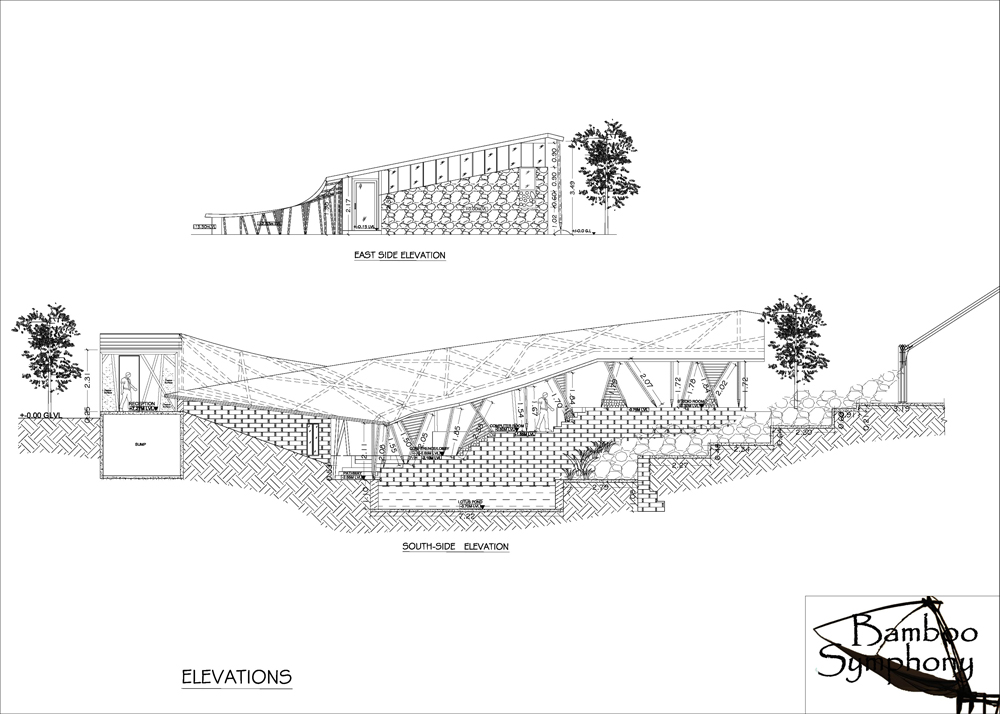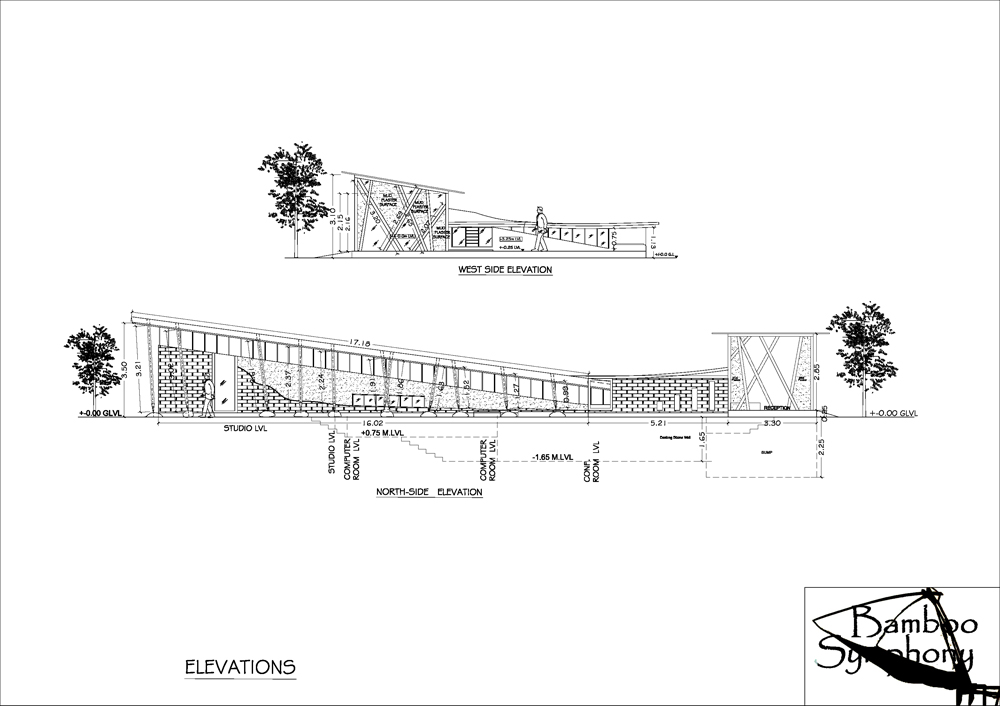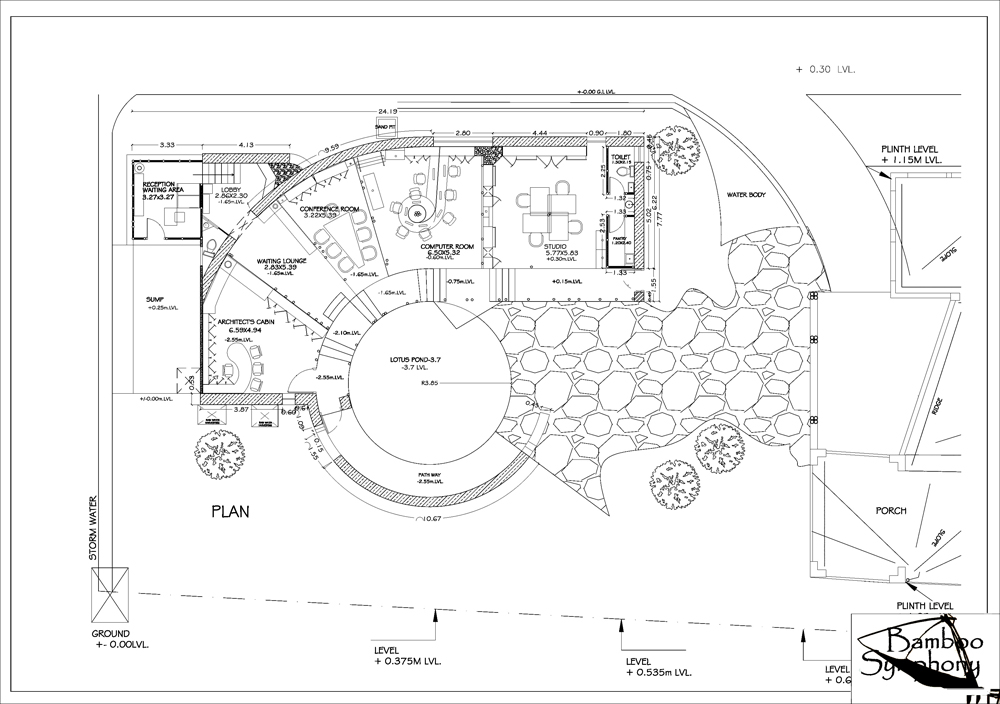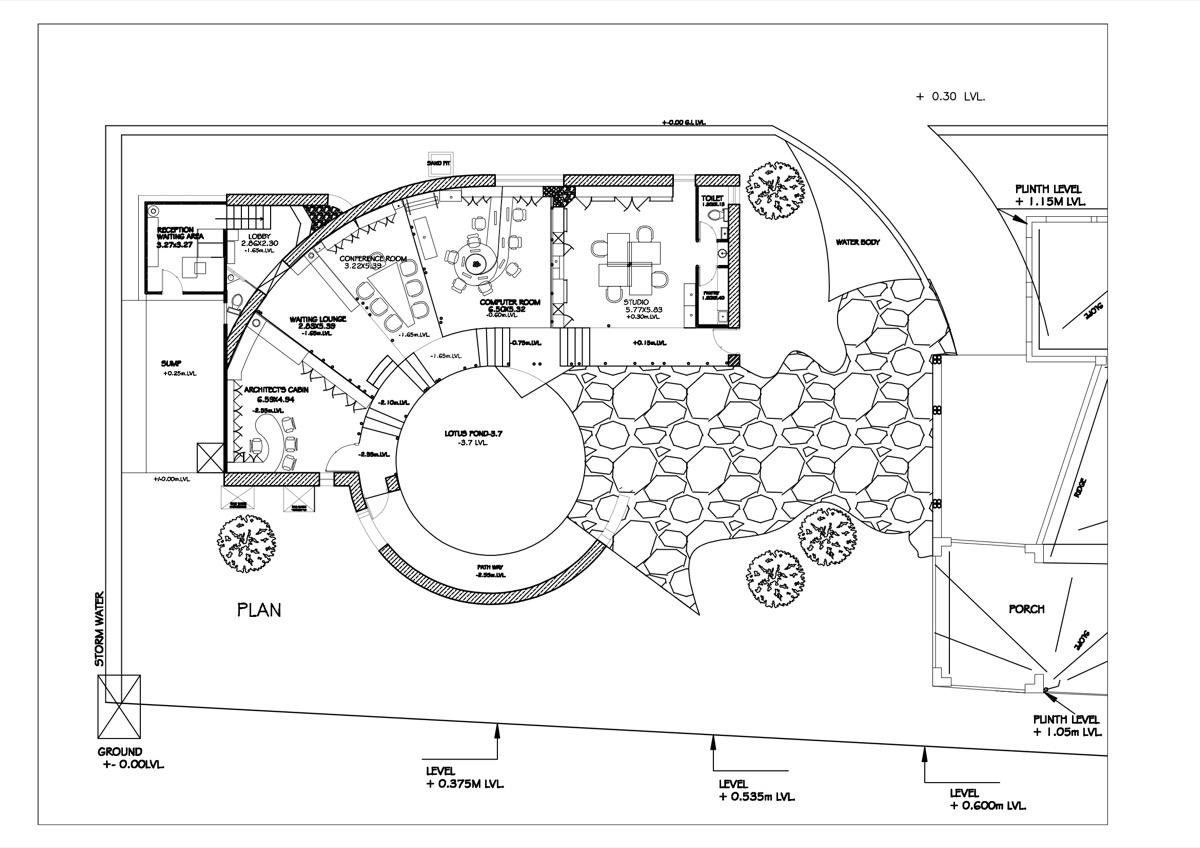
- Bamboo Symphony is the office of Manasaram Architects. Hence, the basic requirement of the Project was to embody all their Design and other Philosophies in the building along with other requirements of Space and Services.
- The office was built adjacent to the principal architect’s residence on a very tight budget.
- All the waste wood, bamboo, stone boulders and debris from house construction and mud were used with Bamboo as the main construction material in the most innovative manner. The office is a Zero Energy Development, with closed loop systems for Building materials, Processes and Technologies.
Performance Standards:

Eligible for IGBC Platinum Rating. (The office is a part of a residence cum office project and hence has shared services. The rating is on hold as it is planned to be carried out for the entire site which is a housing layout).

Architecture:

- Design Principle: Sustainability is embedded in the definition of Architecture itself. The presence of the PANCHMAHABHUTAS, the five elements of nature: water, air, earth, fire and space, has been implemented in a way that tangibly serves all of the three faculties of man, i.e. the psychological, physical and spiritual.
- The office has an open plan with four split levels, all overlooking a central pond. The principal architect’s cabin sits at the bottom level, ensuring visual connectivity across all the spaces.
- The structure draws inspiration from the traditional fishing platforms in India, a truly synergetic structure. Slender bamboo columns harmoniously define the spaces but give a feeling of extreme lightness.
- Rain water Harvesting: The water pond was built with the intention of humidifying the atmosphere which also helps in maintenance of the bamboo members besides recharging the bore well. Extensive with 50,000 litres capacity Rainwater harvesting, the pond is landscaped with a rich variety of locally available water plants and lilies. The existing slope was transformed into a landscaped waterfall directing the rainwater into the lotus pond.
- Ventilation and Thermal comfort: Building orientation and roof form allow for strong North-East and South-West winds to blow over the structure, without any strong drafts inside the building despite it being fully open on the South side. The building is thermally comfortable throughout the year and is aided by below ground level construction.
- Lighting: The building is 100% naturally lit throughout the day. Daylight pipes made from 6″PVC plumbing pipes have been introduced in the slab for areas deeper than 3m and clerestory windows along the entire north facade bring in natural light.
- Onsite Renewable Energy: 1 KW Hybrid Solar Wind power generation meets approximately 20% of the power requirements.
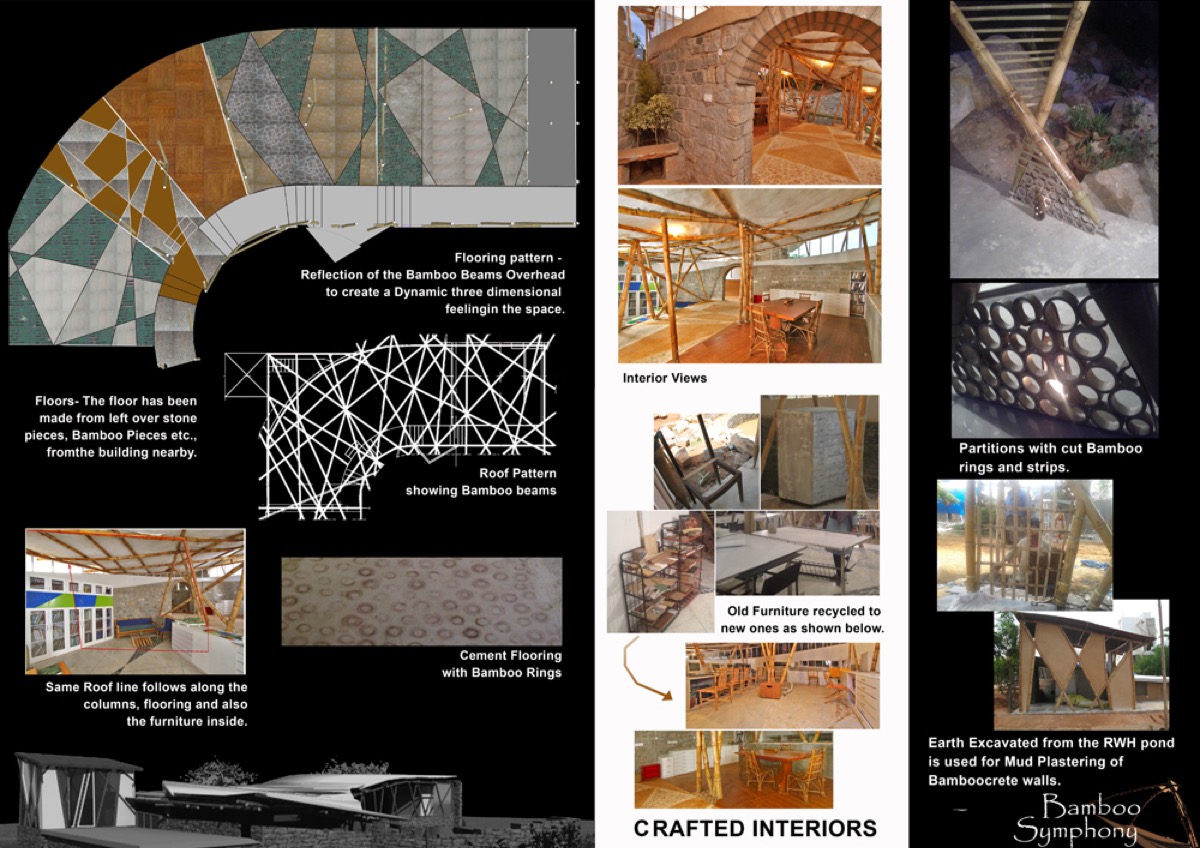
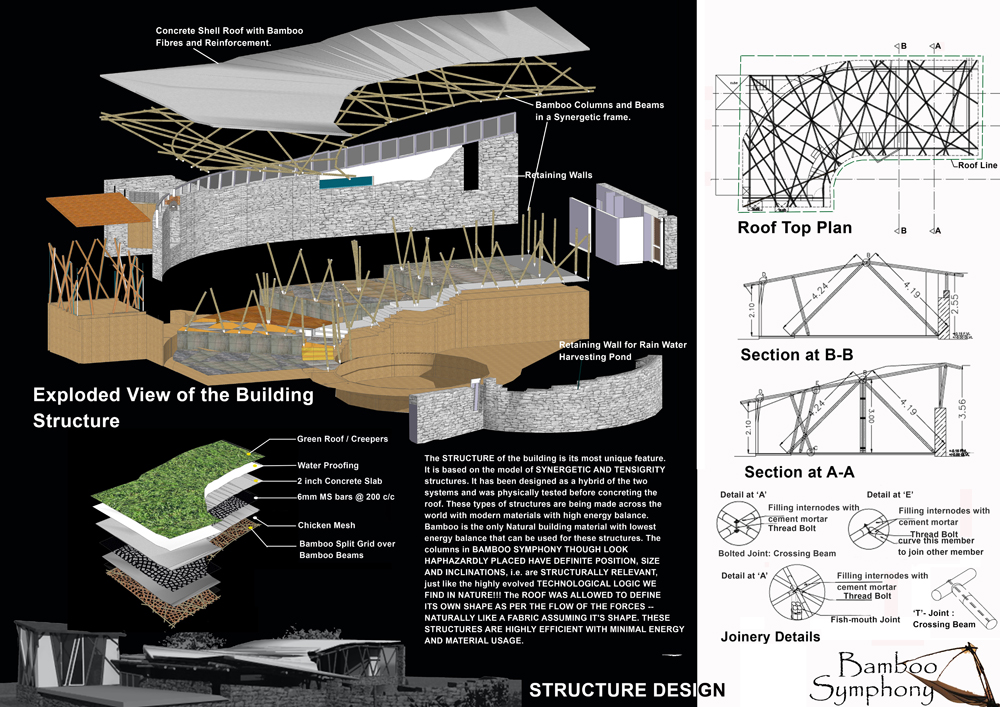
Structure:
The project is a result of intense 2 years of research project, resulting in a Bamboo reinforced slab supported on round bamboo columns and beams, in an economic and innovative manner. A light structure supporting a heavy roof! The use of bamboo fibre reinforced concrete was a novelty as an experiment which rendered positive results.
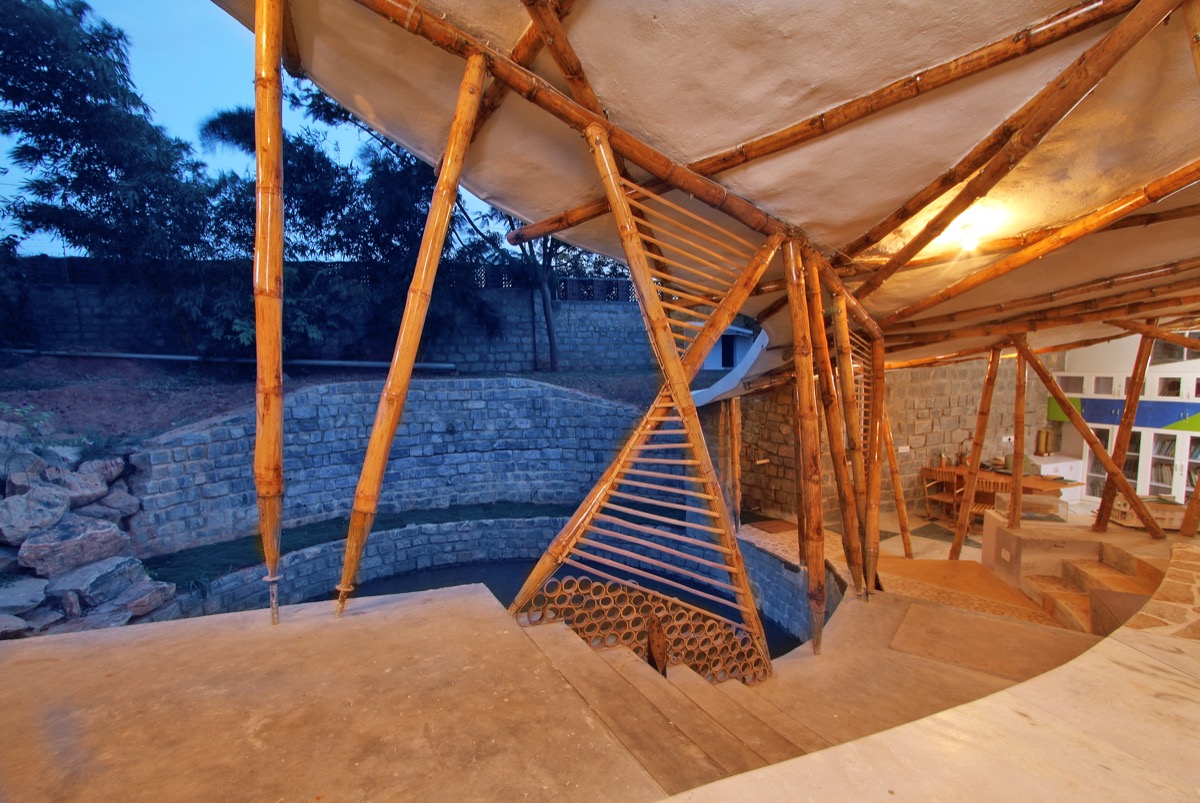
- The columns in Bamboo Symphony though look haphazardly placed, have definite size ,position and inclinations i.e. they are 100% structurally relevant, just like the highly evolved technological logic we find in nature.
- The inclinations in the column members utilize the inherent tensile strength of bamboo.
- The unique roof is a Bamboo Reinforced Slab with Bamboo fibre reinforced concrete (BFRC) (Chicken mesh + Bamboo split mat at 150mm c/c + 6 mm reinforcement bars at 300mm c/c + Water proofing layer). Appropriate amount of Bamboo fibres was mixed in concrete for better bonding and reducing surface cracks. This also reduced the weight of the slab while maintaining the effective depth and increased its structural integrity and tensile strength many times.
- We allowed the roof to define its own shape as per the flow of the forces naturally, like a stretched fabric over the supports. The freeform shell roof gets its shape by the neutralization of forces within the slab, so it poses fewer complexities, with efficient use of materials. Roof was allowed to take a natural shape over the bamboo supports – no formwork used for shaping the roof.
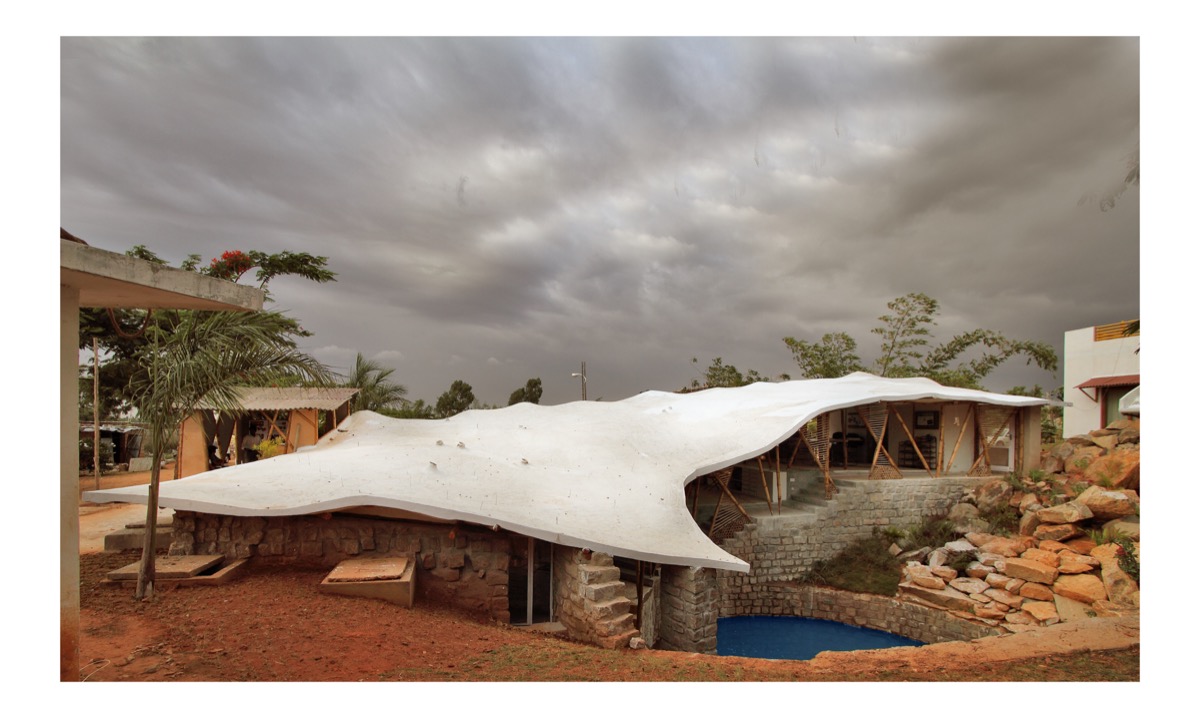
Construction:
- Construction was carried out by unskilled workers, with labour training given during construction.
- Use of locally available materials for construction: Bamboo from local bamboo market, Mud excavated from the site, locally available stone for masonry walls and recycled materials namely Fly ash, recycled wood, scraps metal, stone, debris, plastic bottles, PVC pipes has proved quite cost effective.
- Recycled doors were used from the old office building.
- The Windows are made from Mild steel sections.
- Flooring:
- Combination of Yellow oxide and terrazzo with bamboo rings and waste marble pieces has been used in most of the places.
- Conference hall has Bamboo flooring.
- Finishes:
- Lime wash for Mud block walls
- Touchwood coating for Bamboos
- Silicon Waterproof coating for Stone masonry and interior of bathroom and pantry walls
Material

- Bamboo, the Future Building Material has been used for the structure of the building. The engineering qualities of Bamboo and its intrinsic structure anticipate the principles of many high-tech materials, making it economically efficient, with its attractive appearance an added bonus. Since tensegrity and synergetic structures require light and highly tensile basic elements, Bamboo was used as the main material in this building.
- Three types of Walling systems used:
- Stone masonry
- Compressed Stabilized earth block masonry
- Bamboo-Crete walls (Bamboo poles for main supports at 1.2 m c/c. Bamboo mat and chicken mesh as reinforcement, plastered on both sides).
- Apart from Bamboo; Stabilized Earth Blocks, Stabilized mud plaster, Stone, Stone dust, Waste and Recycled materials were used in the construction. The interplay of these natural materials along with the water bodies resulted in a harmonious structure that connects to the natural elements.
- Recycled and reuse of salvaged materials:
- Materials like stone, bamboo, debris, scrap metal, PVC pipes, plastic and glass bottles have been used in most innovative ways structurally as well as in interiors to produce remarkable aesthetic and design solutions.
- All light Fixtures are made from waste Bamboo sticks, splits, butter sheets and polycarbonate pieces.
- Garden lights Bollards are made of waste pet bottles and Bamboos with LEDs.
The building redefines the designing of an office space by creating an atmosphere that is in constant dialogue with nature. The open plan of the building brings in natural light from all directions throughout the day. The environment thus created enables the architects to stay energetic and creative, reducing stress and fatigue. Manasaram Architects always consider each project as a research project and put their technologies of sustainable construction to the test. The office was also built this way, exploring innovative methods to use natural materials like Bamboo, mud, stone and waste.
Project facts
Client: Manasaram Architects
Site Location: Plot #7, Aditi Greenscapes, Venkateshpura, Bangalore.
Built up area: 210 sq.m
Climate zone: Moderate
Consultants:
Building material & Technology : Centre for Green Building Material & Technology, Bangalore. Rainwater Harvesting : Prof. A.R.Shivkumar, IISc, Bangalore.
Waste Water Treatment : CDD Society, DEWATs, Bangalore.
Compressed Stabilized Earth Blocks : Dr.Yogananda, Mrinmayee, Bangalore.




